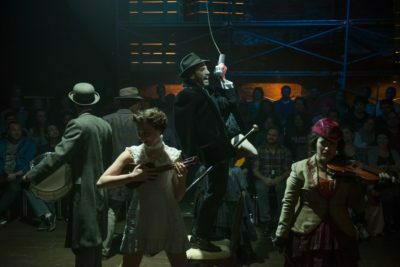Death and Harry Houdini (2016)
 Written and Directed by Nathan Allen
Written and Directed by Nathan Allen
Produced by The House Theatre of Chicago
With their long-running escape room The Last Defender playing downstairs, and their first show, Death and Harry Houdini being revived upstairs, The House Theatre has decisively conquered The Chopin. Both are major hits for the highly innovative company, which use non-standard storytelling techniques, and both, it so happens, force people to rely on their ingenuity to escape mortal peril. Magician Dennis Watkins stands a far better chance of prevailing than the defenders in the basement. In this latest revival, Watkins is at total ease in the role of Houdini, but Nathan Allen’s writing incorporates the escape and magic tricks into a story as exciting as it is tragic and ironic. With the addition of The House’s always evocative music, composed by Kevin O’Donnell, Death and Harry Houdini is far more than a parade of illusions; it captures the magic of theatre, as well.

Watkins, as Houdini, enters suspended upside down in a straightjacket, which he wriggles out of while accompanied by the seven actor/musician ensemble members. The ringmaster (Johnny Arena) regales us with how Houdini was born a Hungarian Jew named Erik Weisz, immigrated to the United States with his family as a child, but lost his father at a young age. The figure of death (Tommy Rapley), striding in on stilts from behind the scenery, and wearing a gas mask as the modern equivalent of a plague doctor’s beak, is presented as a magician in his own right. With sweeping gestures, the phantom displays the saws it uses to cut the father in half, and spirits him away. After that, the young Erik became depressed, until he meets Dr. Lynn (Shawn Pfautsch), a performer whose illusions included conjuring and dissipating living creatures. Erik becomes the man’s apprentice, and takes the name Harry Houdini, in hope of finding a form of magic more powerful than death’s.

A producer advises the young Houdini that his escape act is his most impressive and distinctive performance, and Houdini builds his career on freeing himself from increasingly elaborate locks, knots, and containers. The act also becomes increasingly dangerous, in line with Houdini’s scoffing at death. But before bringing on the famous water torture chamber, and Watkins includes it prominently in the second act, he performs several card tricks, illusions, and injury-defying feats while interacting with the audience. Besides being amazing in their own right, these moments are also used to illustrate the trajectory of Houdini’s career, as they become increasingly morbid and reliant for drama on the audience’s fear for Watkins’s safety. But the show is suffused with humor as well, and so far, the danger has always ended in relief.

The ensemble is made up of House Theatre regulars, some of whom, like this production, have been with the company since its beginning. Carolyn Defrin and Marika Mashburn win big laughs as Houdini’s forever feuding wife and mother, and the actors display proficiency on mandolins, violins, drums, and even kazoos. (The other very talented ensemble members not yet mentioned are Rashaad Hall and Julia Merchant.) O’Donnell’s music is partly klezmer, and partly early blues, true to the vaudeville of Houdini’s time, and the costumes by Lee Keenan, scenic design by Collette Pollard, lighting by Ben Wilhelm, and movements of the actors are all consistent with the pre-naturalistic performance style (there’s even a silent movie about half-way through the show). The entire space feels like Houdini’s world, as seen through his own eyes. This was my first exposure to the show, which Allen revives every so often, and I’ve been told that a few of the magic tricks get switched up each time. All of them are astonishing, but of course, the water torture cell is the one everyone is most eager to see. It does not disappoint, but more importantly, the show establishes a significance for it greater than simply an escapist’s trick. People who have seen Death and Harry Houdini many times remain in awe of it. For those who haven’t yet, it’s a must-see.
Highly Recommended
Jacob Davis
Reviewed May 16, 2016
For more information, see Death and Harry Houdini’s page on Theatre in Chicago.
Playing in the upstairs at the Chopin Theatre, 1543 W Division St, Chicago. Tickets are $45-59; to order, call 773-769-3832 or visit thehousetheatre.com. Performances are Thursdays-Fridays at 7:30 pm and Saturdays and Sundays at 4:00 and 8:00 pm through August 21, with Wednesday performances at 7:30 pm in July and August. Running time is two hours with one intermission.

